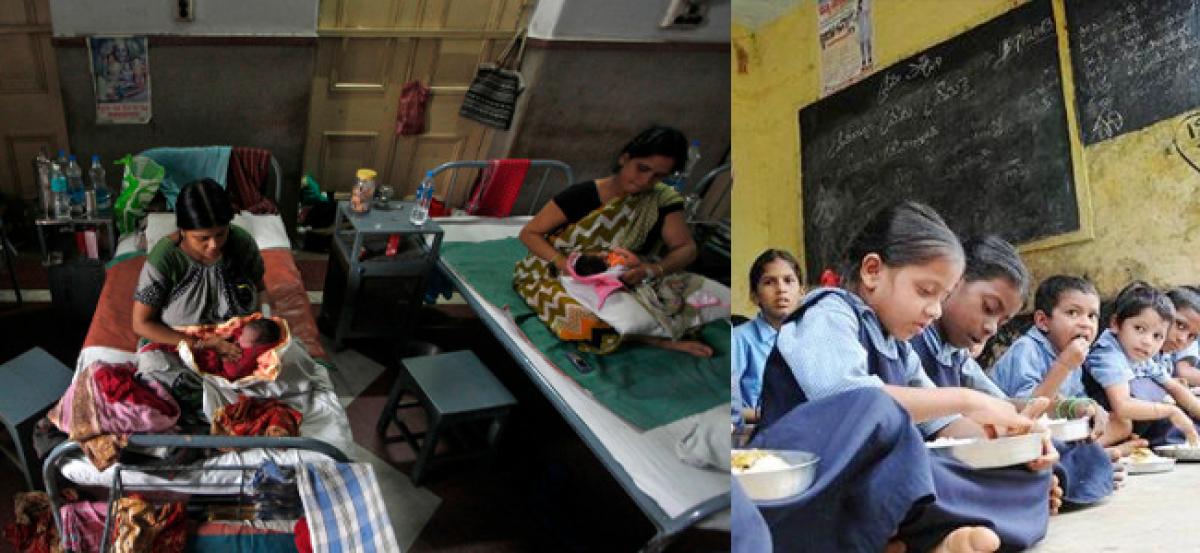Live
- Govt plans to establish offshore Johns Hopkins University Campus in India
- Goa Aces clinch Indian Racing League title
- Study finds how hormone therapy can reshape the skeleton
- High-street fashion players looking at India for manufacturing: Report
- Shreyas Iyer to lead Mumbai as Prithvi Shaw returns for Syed Mushtaq Ali Trophy
- 'Failed to resolve crisis': NPP withdraws support from BJP govt in Manipur
- Chennai: Actress Kasturi Remanded in Custody Until 29th of This Month
- Aaqib Javed likely to become Pakistan's new white-ball head coach
- BJP panel to draft poll charge sheet against AAP govt in Delhi
- Allu Arjun Thanks Fans in Patna, Teases 'Pushpa 2' Release
Just In

The money allocated for key centrally sponsored social schemes — Integrated Child Development Services (ICDS), Sarva Shiksha Abhiyan (SSA or universal education programme) and National Health Mission — has declined 10 percent, 7.5 percent and 3.6 percent over two years.
The money allocated for key centrally sponsored social schemes — Integrated Child Development Services (ICDS), Sarva Shiksha Abhiyan (SSA or universal education programme) and National Health Mission — has declined 10 percent, 7.5 percent and 3.6 percent over two years.
Over the same period, he money set aside for the Swachh Bharat Mission (Clean India Mission) increased almost three times.
The ICDS, SSA and the National Health Mission were carried over from the previous government. The Clean India Mission was started by Prime Minister Narendra Modi.
The cut in social-welfare funding is part of on-going devolution reforms aimed at giving states more money without spending conditions imposed from Delhi.
The states, however, could not match central funding, IndiaSpend reported in February, using the latest data available, from two years ago.
The Bharatiya Janata Party-led National Democratic Alliance (NDA) government cut funding for centrally sponsored schemes 19 percent last year, and the trend continued this year in budget announcements.
While funding for NHM and SSA increased two percent over last year, it is lower than what it was before that.
There was a 55 percent increase in tax money transferred to the states unconditionally, as IndiaSpend reported, based on a study by Accountability Initiative, a New Delhi-based think tank. But some states got less money than before devolution transfers.
Funding cuts aggravated by slow release of money
The 12th Five Year Plan allocated Rs.123,580 crore to ICDS. However, up to financial year 2016-17, the last year of the plan, the central government allocated only 63 percent of the planned ICDS budget.
The National Rural Health Mission (NRHM) allocation in financial year 2015-16 was only 79 percent of the larger National Health Mission, of which NRHM is a part.
The central government provided 57 percent of the allocated SSA budget till September 2015. Of the states’ share, no more than 27 percent, on average, had been released by September 2015.
Slow release of money and funding cuts has led to implementation problems, according to Accountability Initiative budget briefs.
Money has been cut for ICDS, the world’s largest programme for maternal and child care, at a time when 42 perccent of children are underweight and 40 percent are below average height in India, IndiaSpend reported.
The budget of the National Nutrition Mission to combat child malnourishment was Rs.850 crore, doubling from 2015-16. This Mission supplements the ICDS.
Data from the first round of National Family Health Survey-4 (NFHS 4) of 13 states and union territories reveals improvement in maternal and child health, IndiaSpend reported. Data from the most backward states of India such as Odisha, Jharkhand and Uttar Pradesh has not yet been released.
Only 1 percent of Swachh Bharat Mission money spent on changing attitudes
As much as 97 percent of money spent on the Swachh Bharat Mission between April 2015 and February 2016 was on construction of individual household latrines, according to the Accountability Initiative study.
Information, education and communication for sanitation and hygiene accounted for 1 percent of expenditure, a three percentage point drop from 2014-15. Changing attitudes is a critical need, as IndiaSpend reported, in an investigation of the prime minister’s claim that toilets had been built for girls in every school.
Over the last two years, less than half of eligible households that applied for a toilet-construction grant actually received it, according to Accountability Initiative’s district survey.
Only 23 percent of money for education actually spent
No more than 23 percent of the money approved for the universal education programme was spent till September 2015.
As many as 31 percent of schools surveyed by Accountability Initiative across 10 districts in five states had not received their annual grants till December 2015.
The quality of elementary education has been declining in India, as IndiaSpend reported.
Only a fourth of all children in standard III could read a standard II text fluently, a drop of more than 5 percent over five years, according to the 2014 Annual Status Report on Education.
By Saumya Tewari
(In arrangement with IndiaSpend.org, a data-driven, non-profit, public interest journalism platform, where Saumya Tewari is a policy analyst. The views expressed are those of India Spend. The author can be contacted at [email protected])

© 2024 Hyderabad Media House Limited/The Hans India. All rights reserved. Powered by hocalwire.com







